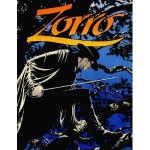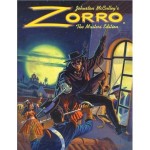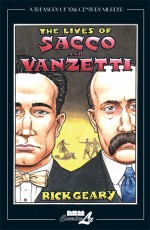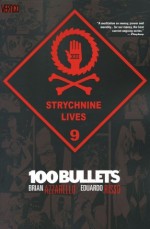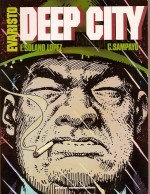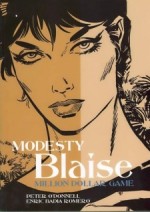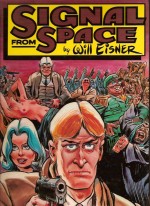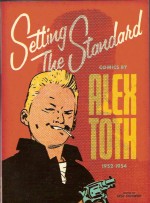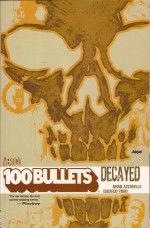
By Brian Azzarello & Eduardo Risso (Vertigo)
ISBN: 978-1-84576-384-8
Not long after Columbus landed in America, thirteen ancient European crime-families migrated to the New World and clandestinely carved up the continent in perpetuity between them. As the country grew cultured and a new nation was born the Trust embedded itself within every aspect of it.
To prevent their own greed and ambition from destroying the sweetest deal in history the Families created an extraordinary police force to mediate and act when any Trust member or faction acted against the unity and best interests of the whole. They were called the Minutemen and were always led by the kind of peacekeeper needed to keep them honest and actively cooperating – a man uniquely honest, dedicated, smart and remorseless.
Not too long ago though, some of The Trust’s current leaders decided they no longer needed overseers and acted with characteristic ruthlessness to remove them.
Betrayed Minutemen captain Agent Graves didn’t take his dismissal well and has been slowly enacting a plan to rectify that casual injustice. For years he has been appearing to various betrayed and defeated people as a “Court of Last Resort†offering answers, secrets, an untraceable handgun and 100 Bullets …
Some of those tragic beneficiaries have been revealed as Minutemen with their personalities hypnotically submerged in cover identities to hide and protect them from the Trust. Gradually they have been reawakened by Graves as he confidentially proceeds with his long range strategy… although no-one really knows what the end-game and ultimate goals are.
With this tenth volume (collecting issues #68-75 of the Vertigo comicbook and the three quarter mark of the stunning adult saga) comes another stunning ratcheting-up of suspense as even more players are removed from the game and the increasingly wary survivors consolidate their positions for the fast approaching apocalyptic finale.
Pay attention when perusing: the uncompromising co-creators have never been accused of underestimating their audience’s intelligence – or appetite for blood, sex, intrigue and ultra-violent action – and these stories need to be carefully studied: both the delightfully sparse words and the shockingly slick pictures…
After an introduction from Darwyn Cooke the ongoing drama re-opens with ‘Sleep, Walker’ and a flashback to 1962 as Axel, leader of House Nagel, is informed by young Augustus Medici that the Minuteman leader Neil Walker has died…
To replace him Medici and Javier Vasco favour the coolly capable Philip Graves, but the junior Minuteman is not so certain he will win the position or the Trust’s full acceptance…
In the present Nagel is a tired old man carried along on Medici’s ambitions and sadly realising his own time has, at last, run out…
As new Trust Warlord Lono targets death-obsessed street-fighter Jack Daw and finally reactivates the next hidden sleeper agent by almost beating him to death, another flashback reveals that some Trust members fear Graves’ Holy Grail has always been a House of his own…
The extended saga ‘A Wake’ reintroduces another capable and nefarious character as low-level enforcer Ronnie Rome hunts for the suicidal mook crazy enough to steal from his gangster boss Mimo. If only all the evidence didn’t point to Ronnie’s wild younger brother Remi…
Meanwhile Axel’s funeral points out a minor problem: as the nine remaining Trust Families swear new allegiance and solidarity to each other a contentious point of order crops up.
Lars and Anna, twins with an unhealthy affection for each other, are the heirs to House Nagel, but since there can be only one undisputed head and the twins are reluctant to choose they must be prodded at all costs into making an irrevocable decision…
Elsewhere, with all the angles weighed, Ronnie readies himself to settle with Remi, but the snotty sibling has found the case, gun and 100 bullets Graves left with the older leg-breaker…
Things turn very nasty when the real thieves are exposed, but the horrific bloodbath that results there is as nothing compared to what happens after one of the Rome boys is revealed as another dormant Minuteman…
And at the highest level of society, Lono works things out with the two potential heirs of Axel Nagel. When he’s done there’s one less House in the Trust…
This volume ends with ‘Amorality Play’ as Graves plays his game in San Francisco, offering young grill-chef and washed-up medical student Dustin his usual deal and briefcase while Lono revels in his growing clout with the Trust and messes with assorted street-punks, predators and lowlifes – just to keep his hand in and to prove what really makes humanity tick…
Wicked, clever, blackly funny and gloriously, gratuitously vicarious, this ultra-violent, sex-stuffed, profanity-packed, utterly addictive thrill ride always delivers maximum punch and every beautiful panel on every thrilling page might hold the final clue to the grand saga unfolding before your eyes. Moreover even whilst playing scrupulously fair the creators are doing their best to shock, mislead and set you up….
Beginning as one of the best crime-comics ever produced, the series developed into a staggeringly plausible and painfully visceral conspiracy thriller of vast scope and dazzling, intricate detail. Over the months and years Brian Azzarello & Eduardo Risso slowly and carefully planted many seeds which grew into a tangle of disparate shoots simultaneously entwining and growing off at tangents before coming together into a perfect mosaic of mood, mayhem and murder.
If there are still any of you rush-starved story fans – grown-up, paid-up, immured to harsh language and unshaken by nudity, rudity and very violent behaviour – who haven’t seen this compulsive classic yet, get out there and grab every one of these graphic novels at all costs! You need them all and the very best is yet to come…
© 2006 Brian Azzarello, Eduardo Risso & DC Comics. All Rights Reserved.


